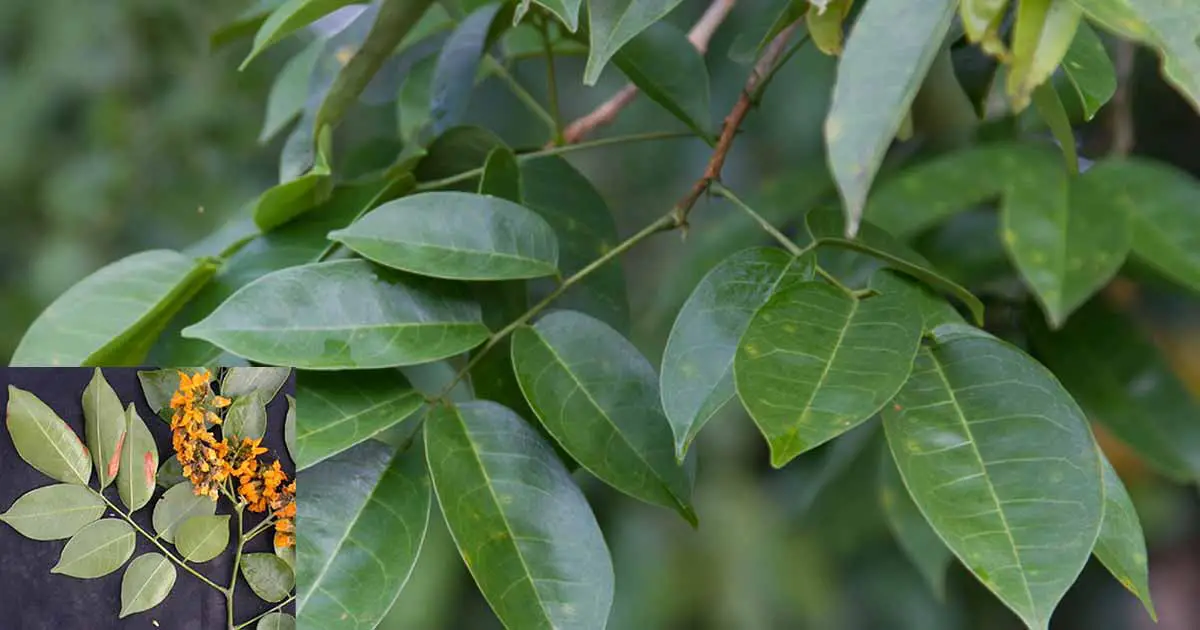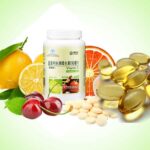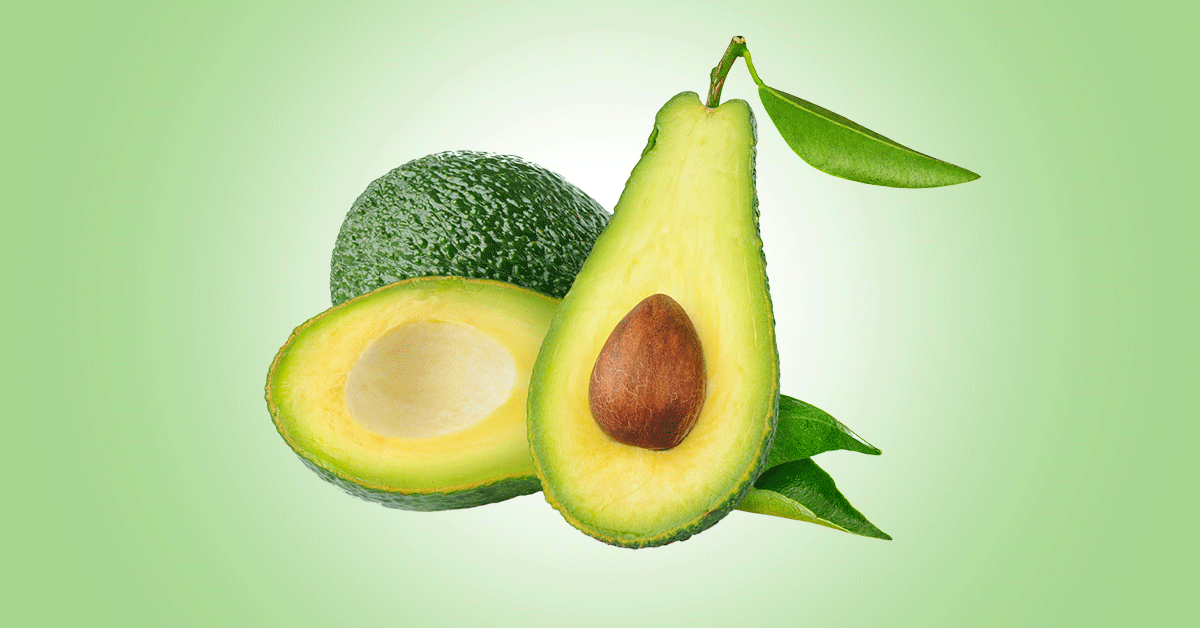Pterocarpus santalinoides is an evergreen small plant from the Papilionaceae family (Leguminosae – Papilionoideae, Fabaceae). The young, tender leaf of the vegetable is edible, and are used for cooking soup. Roasted seeds are also edible, and taste slightly like groundnut. However, the raw seed is toxic.
Pterocarpus santalinoides is called mutititi, Nturukpa in Igbo, Gbengbe in Yoruba, and Gyadar kumi in Hausa.
The plant that can grow up to 15 m tall is widely distributed in riverine forests in Africa and tropical South America (Nigeria, Ghana, Cameroon, Senegal, Brazil).
Leaves are alternate, compound, with up to nine leaflets. The leaflets are alternate to almost opposite, ovate to elliptical, papery to thinly leathery, sparsely hairy below when young but soon glabrescent with lateral veins. The flowers are bright yellow to orange-yellow.
Fruit an almost orbicular, flattened, indehiscent pod, wrinkled, brownish, hairy, with 1 to 2 seeds. The seed is kidney-shaped, and dark brown. The bark is thin greyish brown surface, inner bark is yellowish white to pinkish with red stripes, and exudes a little reddish gum.
In traditional medicine, the Pterocarpus santalinoides has been used to shorten labor time, while the leaf decoction is used to promote wound healing, as febrifuge, and to treat haemorrhoids and fever. The leaves are used alone, or in combination with other plants by traditional healers in Southern Nigerian and Ivorian rural villages to treat blood parasitic infections like trypanosomiasis and malaria. The bark is used for tooth and mouth diseases, while the bark resin serve as astringent for treating severe diarrhea and dysentery.
The leaves are also used for skin conditions like eczema, candidiasis, and acne (Osuagwu and Akomas, 2013). Bark extract are also utilized for diabetes, cough and sore belly (Igoli et al., 2005; Okwuosa et al., 2011). Other uses include treatment of amoebic dysentery, sleeping sickness, stomach-ache, and bronchial complaints.
Constituents
P. santalinoides contains moisture content (10.74±0.02), ash content (7.83±0.052), crude fiber (9.46±0.05), carbohydrate (51.37±0.05), crude protein (16.32±0.01), and higher amount of dry matter (89.26±0.02), ether extract (4.25±0.01). The seed has low fat content.
Mineral composition in the leaf includes calcium, potassium, phosphorus, sodium, magnesium, and vitamin like ascorbic acid.
Pterocarpus santalinoides leaves contain saponins, alkaloids, phenolic compounds, flavonoids, tannins, steroids, coumarins, cyanogenic glycosides, leucoanthocyanins. The wood and stem has high tannin content.
However, it contains more quantity of antinutrients such as phytic acid, hydrogen cyanide, and oxalates more than oha leaf (Pterocarpus soyansii), another highly utilized plant of the Pterocarpus genus.
Health Benefits of Pterocarpus santalinoides
Antibacterial activity:
The plant leaf, stem bark and root extracts showed variable antimicrobial activities against bacteria strains of S. aureus, E. coli, Salmonella sp., and P. aeruginosa. The stem bark extract exhibited a bactericidal effect on all strains, while the leaf and root extracts exhibited both bactericidal and bacteriostatic activities.
Antimicrobial activity is attributed to tannins, flavonoids, saponosides, and alkaloids (Aimé Cézaire Ayéna et al., 2021).
Antioxidant effect:
The plant extract of Pterocarpus santalinoides contains polyphenols, flavonoid, and anthocyanins. These compounds are antioxidant and are free radical scavengers. They ameliorate the emergence of cardiovascular diseases, cancers and aging.
Antidiabetic activity:
The methanol extract of P. santalinoides significantly reduced the fasting blood glucose in alloxan-induced diabetic rats (Kelechi Gideon Madubuike et al., 2023)
A compound isolated from the plant extract called isovitexin has antioxidant, anti-inflammatory, anti-cancer, analgesic, neuroprotective and hypoglycemic effects (Yao et al. 2011). The antidiabetic effect could be through α-glucosidase and α-amylase inhibition, and antioxidant modulation.
Antitrypanosomal activity:
The plant extract was tested for in vitro antitrypanosomal activity using albino rats infected with trypanosomiasis using intraperitoneal injection (Chukwunonso F Obi et al. 2019). The Pterocarpus santalinoides extract reduced the parasitaemia level, and improved survivability, packed cell volume, total leucocyte count, and total erythrocyte count. This suggests it may possess antitrypanosomal activity.
Anti-inflammatory action:
The anti-inflammatory effect of the plant extract was tested on rats induced with edema using carrageenan administration. The leaf, stem bark, and root extract of Pterocarpus santalinoides exhibited variable inhibition of edema (Aimé Cézaire Ayéna et al., 2021)
Antimalarial activity:
The stem extracts of Pterocarpus santalinoides showed a slight antimalarial activity against Plasmodium falciparum strains.
Antipyretic activity:
In an animal model (rats) induced with pyrexia using subcutaneous injection of brewer’s yeast in normal saline, the leave extracts of Pterocarpus santalinoides showed a dose dependent reduction of pyrexia, similarly to aspirin, a standard drug.
The activity could be attributed to steroids, an anti-inflammatory compound found in the plant (Anowi Chinedu Fred et al. 2012).
Treatment of diarrhea:
Diarrhea is an infectious disease caused by pathogenic bacteria such as enterotoxigenic E. coli, Shigellae spp., and other bacteria like Staphylococcus aureus, Salmonella typhi. S. aureus. They produce enterotoxin that causes inflammation of the ileum and diarrhea.
The methanol leaf extract of P. santalinoides was tested for anti-diarrheal effect using castor-oil induced diarrheal rats. The extract showed a dose dependent (200 mg/kg) inhibition of diarrhea, and inhibition of gastrointestinal motility, contraction induced by histamine, and acetylcholine on isolated rabbit jejunum. The antidiarrheal and antispasmodic effects, which could be through inhibition of histaminergic and cholinergic mechanisms (TC Okoye et al. 2010)
Lipid lowering effect:
The aqueous leaf infusion of P. santalinoides exhibited lipid lowering effect in guinea pigs, which could be attributed to their antioxidant property (Ihedioha et al., 2018).
Protects the liver:
In animal studies using CCl4 to induce hepatotoxicity in rats, the plant leaf extract lowered serum liver enzymes like serum alanine aminotransferase, aspartate aminotransferase and serum total bilirubin level, and malondialdehyde. It increased antioxidant enzymes such as superoxide dismutase and glutathione peroxidase levels (Thelma Ebele Ihedioha et al., 2019).
Ihedioha et al. (2017) reported that the methanol leaf extract of P. santalinoides restored hepatocellular integrity in acetaminophen- induced hepatotoxicity in albino rats, while also lowering the serum total cholesterol.
Larvicidal activity:
The seed oils of Pterocarpus santalinoides exhibit larvicidal activity against the larvae of A. aegypti (M A Adeleke et al., 2009).
Side Effects
In acute toxicity test, a 5000 mg/kg of Pterocarpus santalinoides was tolerated by the rats, without any significant adverse effect or changes in their body and organ weights.
References
- https://www.researchgate.net/publication/327599227_Phytochemical_and_mineral_content_in_leaves_stem_and_bark_of_Pterocarpus_santalinoides_nturukpa_from_Afikpo_Ebonyi_State_Nigeria
- https://pubmed.ncbi.nlm.nih.gov/31306694/
- https://uses.plantnet-project.org/en/Pterocarpus_santalinoides_(PROTA)
- https://eijppr.com/storage/models/article/VBRtDeav2u6rPcYPN48abotX4NALYAFDCLu3ncHkAMYki2vOVKioYXN45mg5/preliminary-phytochemical-screening-evaluation-of-acute-toxicity-and-antipyretic-activity-of-metha.pdf
- https://academicjournals.org/journal/AJPP/article-full-text-pdf/974F4AE62532
- https://www.researchgate.net/publication/333868412_The_Phytochemical_Screening_And_Nutritional_Compositions_Of_Pterocarpus_Santalinoides_Plant
- https://www.scielo.br/j/bjps/a/Wr78TdZMJzZhByyNKsyQV8j/?format=pdf&lang=en
- https://doi.org/10.1155/2021/8938534
- https://doi.org/10.4314/thrb.v11i4.50198
- https://www.ajol.info/index.php/njpr/article/view/73938












